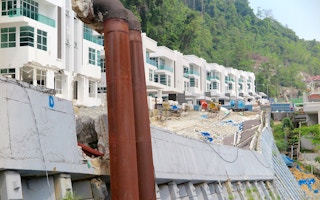Muddy carpets and soaked furniture lay in moldering piles on the streets of this state capital. It was Sunday morning, Oct. 29, 2017. Eight days earlier, torrents of water had poured off the steep slopes of the island’s central mountain range. Flash floods ripped through neighborhoods. A landslide killed 11 workers at a construction site for a high-rise apartment tower, burying them in mud. It was Penang Island’s second catastrophic deluge in five weeks.
Kam Suan Pheng, an island resident and one of Malaysia’s most prominent soil scientists, stepped to the microphone in front of 200 people hastily gathered for an urgent forum on public safety.
Calmly, as she’s done several times before, Kam explained that the contest between Mother Earth’s increasingly fierce meteorological outbursts and the islanders’ affection for building on steep slopes and replacing water-absorbing forest and farmland with roads and buildings would inevitably lead to more tragedies.
“
It exceeds the carrying capacity of the island. It should never be approved.
Gurmit Singh, founder and chairman, Centre for Environment, Technology and Development Malaysia
“When places get urbanised, the sponge gets smaller. So when there is development, the excess rainwater gets less absorbed into the ground and comes off as flash floods,” she said. “The flood situation is bound to worsen if climate change brings more rain and more intense rainfall.”
Five days later it got worse. Much worse. On Nov. 4, and for the next two days, Penang was inundated by the heaviest rainfall ever recorded on the island. Water flooded streets 3.6 meters (12 feet) deep. Seven people died.
The long-running civic discussion that weighed new construction against the risks of increasingly fierce ecological impediments grew more urgent. George Town last year joined an increasing number of the world’s great coastal cities—Houston, New Orleans, New York, Cape Town, Chennai, Jakarta, Melbourne, São Paulo—where the consequences are especially vivid.
Penang’s state government and Chow Kon Yeow, its new chief minister, recognise the dilemma. Three weeks after being named in May to lead the island, Chow told two reporters from The Star newspaper that “[e]conomic growth with environmental sustainability would be an ideal situation rather than sacrificing the environment for the sake of development.”
But Chow also favors more growth. He is the lead proponent for building one of the largest and most expensive transportation projects ever undertaken by a Malaysian city: a $11.4 billion scheme that includes an underwater tunnel linking to peninsular Malaysia, three highways, a light rail line, a monorail, and a 4.8-kilometer (3-mile) gondola from the island to the rest of Penang state on the Malay peninsula.
The state plans to finance construction with proceeds from the sale of 1,800 hectares (4,500 acres) of new land reclaimed from the sea along the island’s southern shore. The Southern Reclamation Project calls for building three artificial islands for manufacturing, retail, offices, and housing for 300,000 residents.
Awarded rights to build the reclamation project in 2015, the SRS Consortium, the primary contractors, are a group of national and local construction companies awaiting the federal government’s decision to proceed. Island fishermen and their allies in Penang’s community of environmental organisations and residential associations oppose the project, and they proposed a competing transport plan that calls for constructing a streetcar and bus rapid transit network at one-third the cost. (See Mongabay – https://news.mongabay.com/2017/04/is-a-property-boom-in-malaysia-causing-a-fisheries-bust-in-penang/)
Gurmit Singh, founder and chairman of the Centre for Environment, Technology and Development, Malaysia (CETDEM), and dean of the nation’s conservation activists, called Penang state government’s campaign for more growth and mega infrastructure development “a folly.”
“It exceeds the carrying capacity of the island. It should never be approved,” he said in an interview in his Kuala Lumpur office.
Singh, who is in his 70s and still active, was raised on Penang Island. He is an eyewitness to the construction that made much of his boyhood geography unrecognisable. “Everything built there now is unsustainable,” he said.
It’s taken decades to reach that point. Before 1969, when state authorities turned to Robert Nathan and Associates, a U.S. consultancy, to draw up a master plan for economic development, Penang Island was a 293-square-kilometer (113-square-mile) haven of steep mountain forests, ample rice paddies, and fishing villages reachable only by boat.
For most residents, though, Penang Island was no tropical paradise. Nearly one out of five working adults was jobless, and poverty was endemic in George Town, its colonial capital, according to national records.
Nathan proposed a path to prosperity: recruiting electronics manufacturers to settle on the island and export their products globally. His plan emphasized the island’s location on the Strait of Malacca, a trading route popular since the 16th century that tied George Town to Singapore and put other big Asian ports in close proximity.
This story was published with permission from Mongabay.com. Read the full story.










